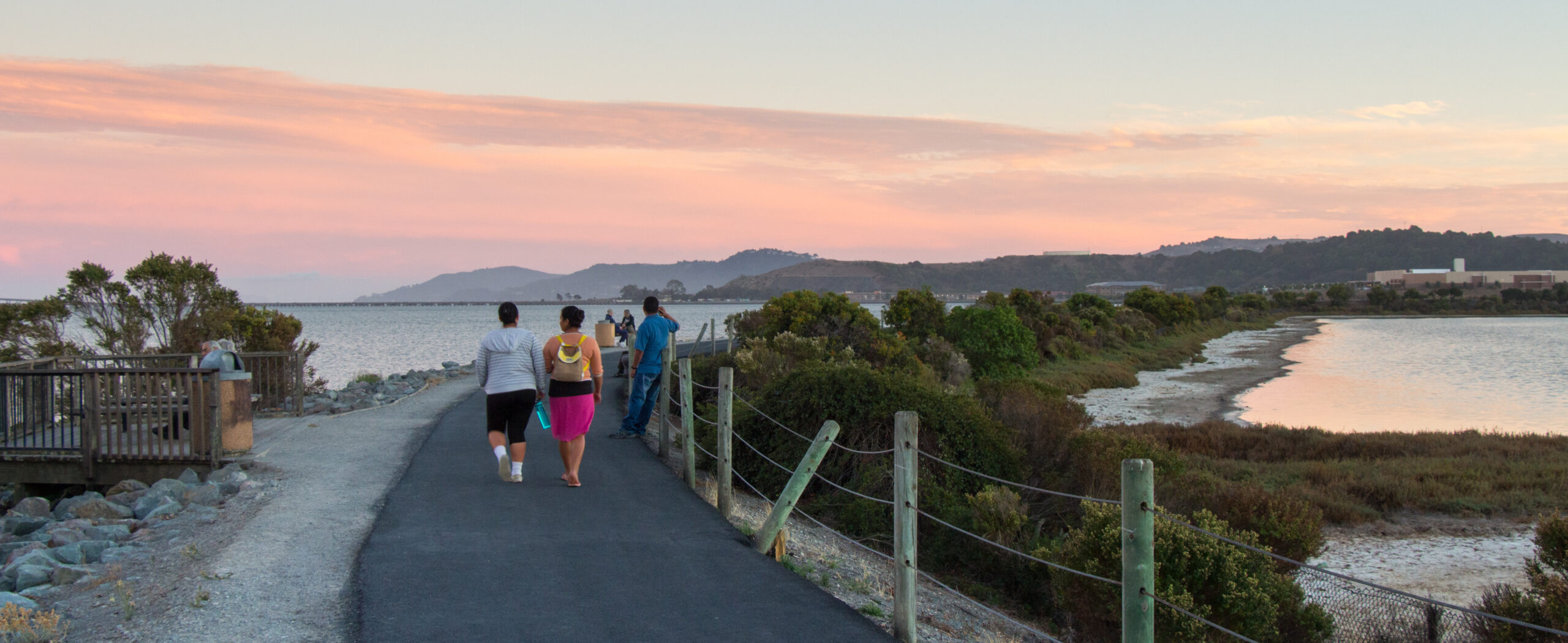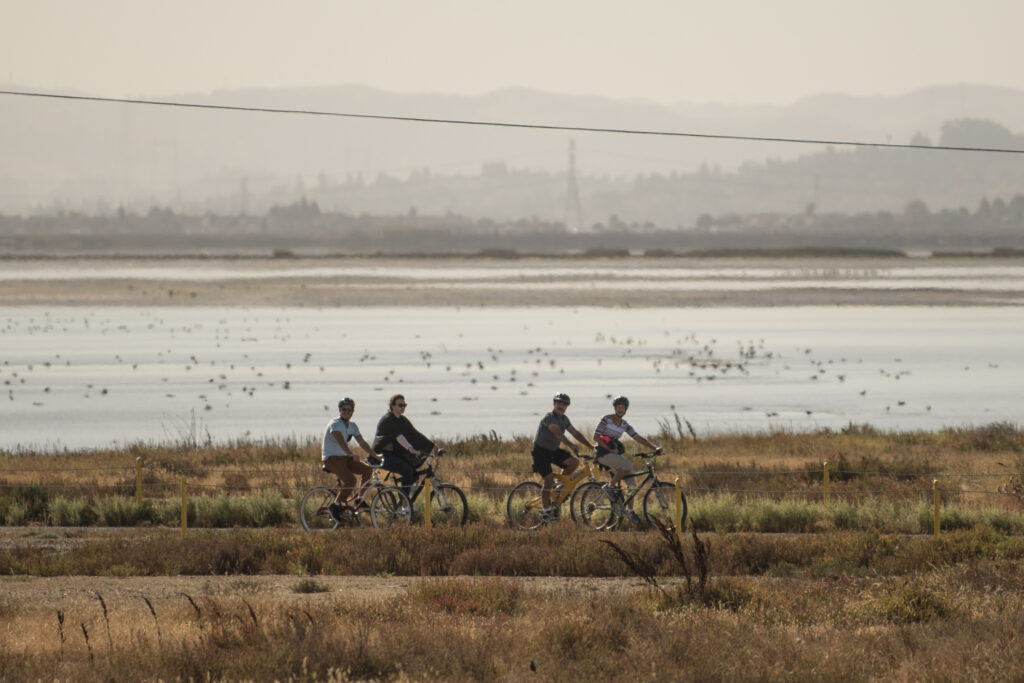
It’s largely taken for granted within the San Francisco Bay environmental community today that public trails through parks and preserves are both right and good: right, in the sense that they can offer equitable access to our region’s most treasured natural assets; and good, because they engender support for protection and restoration. But along the waterfront, trails weren’t always so welcome.
“The local chapters of the Audubon Society and the Sierra Club were adamantly opposed,” recalls Tom Mikkelsen, who led implementation of the Bay Trail, an ambitious multi-use trail ringing the Bay, from its inception in 1988 until 2001. “Every time we came up with a project that was close to the edge of the Bay, they opposed it. And the issue was that ‘it had to be preserved, and preservation was the first order of business.’”
Their concern that more access to the shoreline would imperil its remaining habitat was not entirely unfounded. It likely came as an over-correction for abuses the Bay had suffered in previous years through dumping and infill, damages that gave rise to the Bay Area environmental movement in the first place. Yet slowly, over the course of decades, the once-paradoxical concept that access might translate to protection became common sense within the restoration community. “They eventually saw these things as mutually supporting,” Mikkelsen says.
During his 13-year tenure, the San Francisco Bay Trail grew by almost 100 miles. The system’s total mileage today is just north of 350, with 150 more needed to complete the trail. But the annual growth rate has slowed to a crawl as only the most difficult segments remain.
One recent addition exemplifies how current roadblocks to Bay Trail expansion aren’t political in nature, but logistical. More importantly, it illustrates the progression of public-access goals since the late 1980s, from simply building trails to prioritizing equity and community engagement.
When complete in the summer of 2026, the India Basin Waterfront Park Project will transform a section of San Francisco’s shoreline in the Bayview-Hunters Point neighborhood from a polluted former industrial site to a thriving natural area and gathering spot with a restored shoreline. It will also close a small yet critical gap in the San Francisco Bay Trail and serve as the midpoint of the 1.5-mile India Basin shoreline trail, which spans a total of seven properties including restored Heron’s Head Park to the north.
Part of the project area was so degraded by previous uses (with no existing marsh to preserve) that multiple trails, docks, buildings, and recreational facilities could be considered from the start—with community input—right alongside plans for upland plantings and new shoreline and wetland habitat. Public access and environmental restoration goals were considered together throughout the design and permitting process, says San Francisco Recreation and Parks Department project manager David Froehlich. SF Rec and Parks, which owns the land, collaborated particularly closely with the Bay Conservation and Development Commission (BCDC), Froehlich notes—an organization whose mission, alongside protecting and enhancing the Bay, involves providing public access.
Similarly, the voter-approved San Francisco Bay Restoration Authority, which contributed nearly $5 million to the project’s $200 million budget, considers public access an essential element of its mandate. So does the State Coastal Conservancy, which helps run the Restoration Authority; in recent years, its concept of access has broadened well beyond the Bay Trail itself to include other design elements that are responsive to community needs, as well as transportation to and from shoreline parks and trailheads.

The pandemic has accelerated this ongoing evolution in thinking at agencies around the Bay, says San Francisco Estuary Partnership director Caitlin Sweeney. “It really drove home the point that access to open space is so critical for our health and well- being, but is not provided equitably throughout our region,” she says. “I think that’s where we’re gonna see the push. We’re also going to see an acknowledging of the different ways we use open space.”
Still, public access must remain compatible with other goals. Different agencies with which the Coastal Conservancy partners manage different properties for different purposes, says deputy program manager Jessica Davenport. For example, “there are California State Parks that are more oriented toward public access and recreation. But California Wildlife Areas are primarily for wildlife.” There, public access is, by law, “focused on wildlife-oriented recreation, like fishing, hunting, bird watching,, and nature study, [and] they have a very limited budget to maintain public facilities,” Davenport says.
Case in point: the California Department of Fish and Game’s Napa-Sonoma Marshes Wildlife Area. If India Basin is on one end of the public-access spectrum among San Francisco Bay wetlands, this vast tidal complex surrounding Highway 37 is on the other: difficult to access (mostly by boat) and ultimately managed for wildlife.
The area also includes the largest remaining contiguous gap in the San Francisco Bay Trail, planned to one day follow the highway’s path across the marsh. Mikkelsen says he remains optimistic, just as he was in the late 1980s, that the trail will eventually be completed. “I’d hoped to see this thing done by the time I retired,” he says. “That didn’t happen. So now I’m hoping that I’ll see it by the time I kick the bucket. And that may may not happen. But maybe my kids or their children will be able to [see] it, and I think that’s terrific.”
After all, few experiences are more inspirational, and more motivating to continue to protect this regional centerpiece, than reaching the Bay’s edge, peering over sinewy channels of healthy tidal marsh toward miles of open water, and contemplating how far we’ve come.
Top Photo: Bay Trail in Richmond. Photo: Ben Botkin
Prior Estuary News Stories